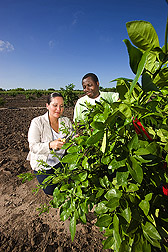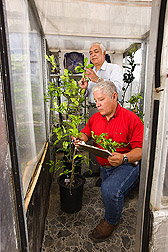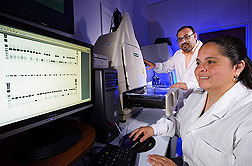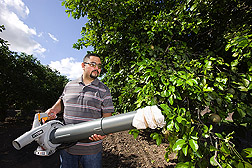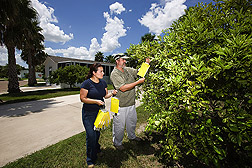Citrus Greening?
Not If These Scientists Can Help It!
In the Rio Grande Valley of southern Texas, citrus orchards cover the landscape. Texas is the third largest producer of citrus fruit in the United States, and most of it is grown in the Rio Grande Valley. Here, grapefruit is king, but orange, tangerine, tangelo, and Meyer lemon are also grown.
A couple of years ago, growers in this region started seeing a new insect on their citrus trees: the Asian citrus psyllid. This tiny pest is responsible for transmitting the deadly citrus greening disease, also known as “Huanglongbing,” which devastated the Florida citrus industry in 2005.
Fearing they would have an outbreak of the same magnitude, Texas growers approached Agricultural Research Service scientists at the Kika de la Garza Subtropical Agricultural Research Center (SARC) in Weslaco, Texas, for help in preparing for an outbreak.
“We have yet to see citrus greening in our area, but the presence of the Asian citrus psyllid means it may be only a matter of time until trees become infected,” says Robert Mangan, research leader of the Crop Quality and Fruit Insects Research Unit (CQFIRU) at SARC and areawide project manager. “That’s why our scientists are working closely with federal and university collaborators to develop an areawide approach to control infection and spread of the disease.”
Understanding Psyllid Habits
Every week, CQFIRU entomologist Donald Thomas visits citrus groves to collect samples of psyllids and potential predators. Using a small, modified hand-held vacuum and sticky traps attached to trees, Thomas has monitored psyllid populations in the area over the past year. As expected, he found that psyllid populations fluctuate depending on the amount of rain in the area. After heavy rains, psyllid numbers increase as new growth on citrus trees, called “flush,” appears. That’s because the psyllid relies entirely on flushing shoots for reproduction and development.
Thomas also found that psyllid populations tend to decrease during winter, when cool temperatures keep citrus trees from flushing. During this time, he found the psyllids living in other trees surrounding citrus groves, such as torchwood, persimmon, and mesquite. Thankfully, the psyllids don’t seem to be reproducing on these trees, but further testing to determine this is under way. Thomas found abundant psyllids in abandoned citrus groves and urban areas where citrus trees are planted in backyards, indicating the need to develop management tools for use in those areas.
With help from colleagues in Texas and Florida, Thomas has identified at least a dozen psyllid species present in south Texas citrus groves. Some are native to the Rio Grande Valley, but others—like the Asian citrus psyllid—are not. The scientists are examining the life cycles of the species to see whether any of them can spread citrus greening. This is important in helping determine which species to target for control measures.
Thomas is also working with Mexican and U.S. federal cooperators to examine potential biological control agents for the psyllid population. A tiny wasp, Tamarixia radiata, has shown the most promise during observational and preliminary testing. Lacewings, beetles, spiders, and predatory mites are also candidates.
Genetically Identifying the Psyllid
In a related project that complements the areawide project, molecular biologist Jesse de León, with the Beneficial Insects Research Unit (BIRU), and colleagues from North and South America are applying molecular tools to genetically characterize the Asian citrus psyllid. This will help scientists determine where to collect preadapted natural enemies of the insect for a biological control program.
The researchers found two groups of Asian citrus psyllids in the Americas—one prevalent in South America, the other in North America. But through molecular testing, De León found the two psyllid groups to be genetically distinct. This suggests that the Asian citrus psyllid in North America did not come from South America; rather, each continent was probably invaded by insects from different countries in Asia. So, scientists may need to collect natural enemies from various Asian countries to control the psyllids in North and South America.
De León’s team is also studying the T. radiata wasp, one of the psyllid’s natural enemies, to determine whether it exists in the Americas as a single species or as genetically distinct populations. So far, the scientists have identified four groups of T. radiata in the Americas. The scientists will continue to apply other molecular tools and perform cross-mating studies to determine whether these groups represent a single species, very closely related species, or what’s known as “cryptic species,” look-alikes that are genetically different. Accurately identifying T. radiata will help the scientists develop a successful biological control program.
What’s That Smell?
These days, entomologist Joseph Patt’s laboratory smells more like a perfumery than a laboratory. That’s because Patt, who is also with BIRU, is experimenting with petitgrain oils—essential oils used as perfume bases—to see which work best in mimicking the flushing shoots that attract Asian citrus psyllids. The plant volatiles emitted from these shoots may play an important role in helping the psyllids find suitable host plants on which to reproduce. A key aspect of developing a management system for psyllids is to find an attractant for baiting, trapping, and killing them.
The psyllid is commonly found on orange jessamine, a popular ornamental plant related to citrus. By analyzing the volatiles that make up orange jessamine’s scent, Patt was able to formulate a synthetic mixture that proved attractive to psyllids in greenhouse testing.
The Asian citrus psyllid relies on both sight and scent to find food. Patt tested petitgrain oils on yellowish-green-colored cards, developed by Alpha Scents, Inc., to monitor the insect. Greenhouse studies showed that cards scented with petitgrain oils attracted more psyllids than unscented cards did. In the future, the scented, colored cards could be used in urban areas, where wide spraying of pesticides is forbidden, to disseminate biological control agents like fungi that will affect just the psyllid.
While Patt’s results are promising, he must still confirm his findings in the field and conduct further studies to find the combination of scent components that is most attractive to these psyllids.
Inducing Flushing All Year Long
Currently, researchers seeking to better understand the Asian citrus psyllid’s interaction with citrus plants must schedule their studies around when the plants flush. In the race to develop solutions to control citrus greening before it reaches southern Texas, the researchers cannot afford any lost time.
Plant physiologist Nasir Malik, with the Integrated Farming and Natural Resources Research Unit, is coming to their aid. His goal is to induce flushing in citrus trees to allow scientists to conduct year-round testing.
Malik has developed temperature-controlled growth chambers in which to grow citrus plants. He placed grapefruit trees in the low-temperature chambers, which were kept at 4˚–8˚C during the night and 18˚C during the day, for different lengths of time. The plants were then transferred to the greenhouse, where temperatures were warmer (26˚C at night and 29˚C during the day).
The results were outstanding. Malik was able to induce some flushing in trees that stayed in the growth chambers for as little as 2 weeks, but longer treatments induced more flushing. Trees that spent 10 weeks in the growth chambers flowered almost immediately after being transferred to the greenhouse.
Thanks to Malik, scientists can produce new flushes at will, which speeds up testing. Malik plans to expand his testing to longer intervals to see if he can achieve 100-percent flowering on the trees. He has also successfully induced branching, or new flush, in other trees, such as guava, pomegranate, and chapote (Casimiroa greggii), a small tree native to Mexico, thus demonstrating the utility of the technique for the nursery industry in general.
|
|
Need Something Now? Just Look Online
Growers looking for ways to control the psyllids in their citrus groves have a new tool: an online national database of approved pesticides for psyllid control.
Compiled by graduate student Deanna Chapa and university, private industry, and government cooperators, the database is the first organized collection of label information that growers and researchers can rapidly consult to determine which pesticides are effective in their area or on their crop. Users can set up queries based on criteria they select or enter. And if categories need to be added, just contact Chapa, who will continue working on this database.
|
|
With the help of ARS researchers and collaborators, citrus growers and enthusiasts in the Rio Grande Valley will be well prepared for a future citrus greening outbreak.—By Stephanie Yao, Agricultural Research Service Information Staff.
This research is part of Crop Protection and Quarantine (#304) and Methyl Bromide Alternatives (#308), two ARS national programs described at www.nps.ars.usda.gov.
Robert Mangan, Donald Thomas, Jesse de León, Joseph Patt, Nasir Malik, and Deanna Chapa are with the USDA-ARS Kika de la Garza Subtropical Agricultural Research Center, 2413 East Highway 83, Weslaco, TX 78596; (956) 447-6316 [Mangan], (956) 447-6315 [Thomas], (956) 969-4856 [de León], (956) 969-4801 [Patt], (956) 969-4814 [Malik], (956) 447-6320 [Chapa].
"Citrus Greening? Not If These Scientists Can Help It!" was published in the November/December 2010 issue of Agricultural Research magazine.







